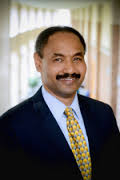During this year’s CRNA Week (#crnaweek), there are many nurse anesthetists who are remembering why they got into the profession, and even more are reflecting on how the face of the profession is changing.
John Bing, BSN, CRNA, American Association of Nurse Anesthetists (AANA) Region 6 director, and national AANA board of directors member, says one of his steadfast missions is to make sure the field continues to attract top nurses, but that it is especially welcoming to aspiring minority nurse anesthetists.
Bing knows first-hand how hard it is being a minority in the field. When he first started out, he was often the only African American in the OR, he says. At times, people assumed he was part of the housekeeping staff. Although he laughs about it now, Bing has made it a direct part of his mission to attract more minorities into this field.
He even takes on leadership positions with the primary goal of making sure he is representing the minorities in the field. “You need to see that in leadership,” he says. “If others don’t see that, they won’t see a place for them. I make sure they see it.”
“Many times you would go in and you were it,” he says of when he started out. “Maybe you were the only one in the hospital or the department. Now you go in and you see a fair amount [of minorities].”
As a president of the Diversity in Nurse Anesthesia Mentoring Program, Bing also makes sure his students know why he enjoys this profession so much.
One of Bing’s specific approaches is to make sure he talks to patients as the anesthesia takes effect. He finds out what they like so they can chat about it—sports, cooking, books, kids—anything that helps them relax. “That’s like a sedative,” he says. “It calms them down and they remember that.”
And while he’s monitoring a patient, Bing does exactly what he teaches his students—he assesses his patient over and over and over. “You must rely on your instinct,” he says. During travels with students to countries like Nicaragua, Bing teaches students that not every machine is calibrated the same or even correctly.
“The machine is a guideline,” he says. “You are ultimately responsible for anything that happens. You can’t blame the machine for anything. Look at the patient.”
Bing says that while he’s checking blood pressure every five minutes or so, he is constantly “circling the block,” as he calls it. All the machines are incredibly helpful, but they should only confirm what a nurse anesthetist is seeing, hearing, smelling, and touching.
And getting stale in this profession is not an option, he says. “I say to my students, ‘Tell me how this patient could die today,’” he says. That forces students to look at the big picture and not just look for complications, but to look for other factors that could impact that patient on that day.
Bing clearly enjoys working with his students, but he understands first-hand how sometimes they are not the ones who chose the profession. “The last thing I thought I would be was a nurse,” he says with a laugh. As an African-American, there were few role models that looked like him.
A chance look at a jobs list that revealed six pages of nursing jobs, convinced Bing, an athlete in high school and college, to take a look. Bing says he turned to his buddy he was working out with and said, “We get to be around girls and have a great job!” But he still didn’t expect to land in this field. Eventually, nurses in the recovery room where he worked nudged him to give it a try.
Now, Bing’s mission is to attract minorities into nurse anesthesiology. He speaks to kids in schools, paying special attention to making the field appealing to boys and young men. As it is, 49 percent of nurse anesthetists are male, he says, which is a high number considering less than 10 percent of all nurses are male.
But Bing lets kids know that there are chances to be out on a helicopter go team or even in the midst of trauma situations. “Men like that kind of stuff,” he says and it certainly gets the attention of younger kids who don’t know those possibilities exist.
Add in the good salary, the camaraderie, and the fair amount of autonomy, says Bing, and a career as a CRNA shows kids who might not initially consider a nursing career that the path is open to more possibilities than they ever imagined.
- WOC Nurses Week Highlights Specialty - April 16, 2024
- Honoring Radiology Nurses Day on April 12 - April 12, 2024
- Travel Offers New Career Possibilities - April 8, 2024



